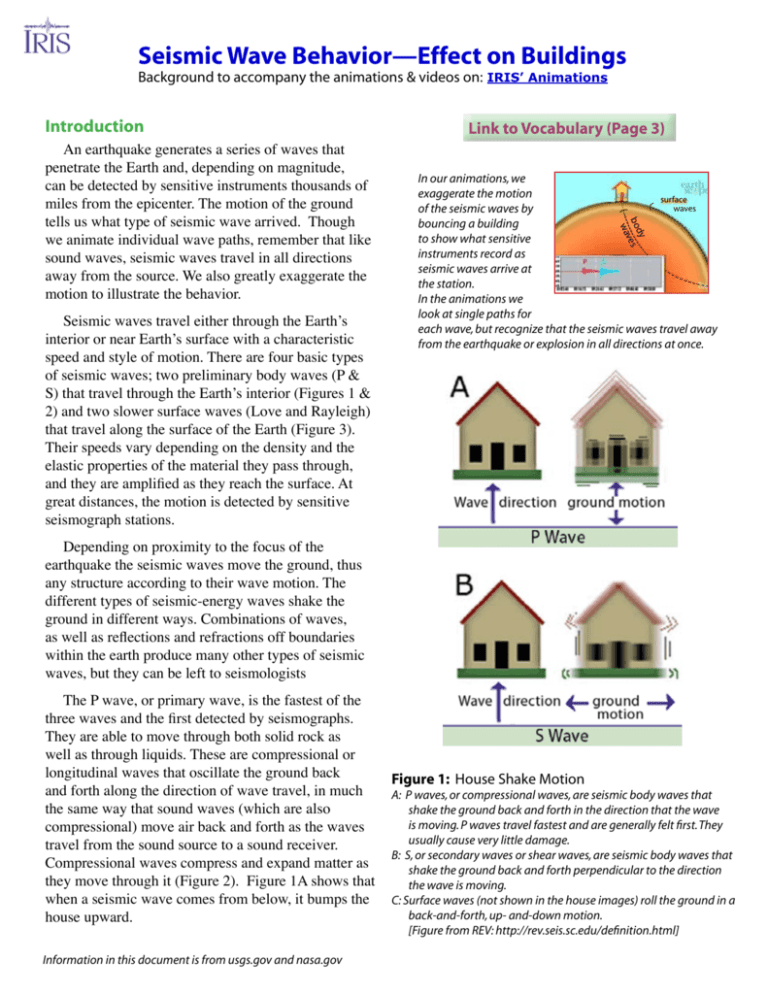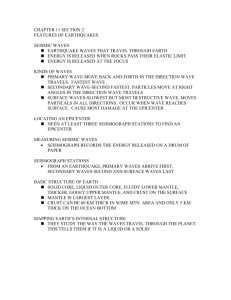Seismic Wave Behavior—Effect on Buildings
advertisement

Seismic Wave Behavior—Effect on Buildings Background to accompany the animations & videos on: IRIS’ Animations Introduction Seismic waves travel either through the Earth’s interior or near Earth’s surface with a characteristic speed and style of motion. There are four basic types of seismic waves; two preliminary body waves (P & S) that travel through the Earth’s interior (Figures 1 & 2) and two slower surface waves (Love and Rayleigh) that travel along the surface of the Earth (Figure 3). Their speeds vary depending on the density and the elastic properties of the material they pass through, and they are amplified as they reach the surface. At great distances, the motion is detected by sensitive seismograph stations. In our animations, we exaggerate the motion surface waves of the seismic waves by bouncing a building to show what sensitive instruments record as seismic waves arrive at the station. In the animations we look at single paths for each wave, but recognize that the seismic waves travel away from the earthquake or explosion in all directions at once. dy bo ves wa An earthquake generates a series of waves that penetrate the Earth and, depending on magnitude, can be detected by sensitive instruments thousands of miles from the epicenter. The motion of the ground tells us what type of seismic wave arrived. Though we animate individual wave paths, remember that like sound waves, seismic waves travel in all directions away from the source. We also greatly exaggerate the motion to illustrate the behavior. Link to Vocabulary (Page 3) Depending on proximity to the focus of the earthquake the seismic waves move the ground, thus any structure according to their wave motion. The different types of seismic-energy waves shake the ground in different ways. Combinations of waves, as well as reflections and refractions off boundaries within the earth produce many other types of seismic waves, but they can be left to seismologists The P wave, or primary wave, is the fastest of the three waves and the first detected by seismographs. They are able to move through both solid rock as well as through liquids. These are compressional or longitudinal waves that oscillate the ground back and forth along the direction of wave travel, in much the same way that sound waves (which are also compressional) move air back and forth as the waves travel from the sound source to a sound receiver. Compressional waves compress and expand matter as they move through it (Figure 2). Figure 1A shows that when a seismic wave comes from below, it bumps the house upward. Information in this document is from usgs.gov and nasa.gov Figure 1: House Shake Motion A: P waves, or compressional waves, are seismic body waves that shake the ground back and forth in the direction that the wave is moving. P waves travel fastest and are generally felt first. They usually cause very little damage. B: S, or secondary waves or shear waves, are seismic body waves that shake the ground back and forth perpendicular to the direction the wave is moving. C: Surface waves (not shown in the house images) roll the ground in a back-and-forth, up- and-down motion. [Figure from REV: http://rev.seis.sc.edu/definition.html] S waves, or secondary waves, are the waves directly following the P waves. S waves travel in the same direction, but instead of being a compressive wave, they oscillate with a shearing behavior at right angles to the direction of motion. Figure 1B shows that though the wave direction is the same as the P wave, the ground motion moves the house side to side. They travel about 1.7 times slower than P waves. Because liquids will not sustain shear stresses, S waves will not travel through liquids like water, molten rock, or the Earth’s outer core. S waves are more dangerous than P waves because they have greater amplitude and produce vertical and horizontal motion of the ground surface. For many classroom applications simply addressing P and S waves is enough, but it is also good to know about the destructive and convoluted surface waves. Figure 2—This diagram shows how, at a microscopic level, the particles move during compressive P waves or shearing S waves. The arrows on the right show direction of wave travel. These waves travel in paths through the Earth. This last type of wave, and the slowest, is the surface wave which moves close to or on the outside surface of the ground. There are two types of surface waves: 1) Love waves move like S waves in that they have a shearing motion in the direction of travel, but the movement is back and forth horizontally. 2) Rayleigh waves move both horizontally and vertically in a vertical plane pointed in the direction of travel. Love and Rayleigh waves both produce ground shaking at the Earth’s surface but very little motion deep in the Earth. Because the amplitude of surface waves diminishes less rapidly with distance than the amplitude of P or S waves, surface waves are often the most important component of ground shaking far from the earthquake source, thus can be the most destructive. Other animation sets in our series that complement this set include: 1) 3-Component Seismograph 2) Multi-Station Seismograph Network 3) Travel-time Curves Figure 3—Surface waves travel at or near the surface of the Earth only. These can be the most destructive waves in that they appear to roll along lifting and dropping the ground as they pass. Vocabulary Amplitude—the maximum disturbance or distance from the constant point. The amplitude of a seismic wave is the amount the ground moves as the wave passes by. (As an illustration, the amplitude of an ocean wave is one-half the distance between the peak and trough of the wave. The amplitude of a seismic wave can be measured from the signal recorded on a seismogram.) Asthenosphere —layer of the Earth found 100-500 km below the Earth’s surface that yields to persistent stresses more than the rigid crust or the core. Click here to see an image Body Waves—waves that move within the Earth’s interior or within a body of rock. Compression—fractional decrease of volume due to pressure. Earthquake—shaking or trembling of the earth that accompanies rock movements extending anywhere from the crust to 680 km below the Earth’s surface. It is the release of stored elastic energy caused by sudden fracture and movement of rocks inside the Earth. Part of the energy released produces seismic waves, like P, S, and surface waves, that travel outward in all directions from the point of initial rupture. These waves shake the ground as they pass by. An earthquake is felt if the shaking is strong enough to cause ground accelerations exceeding approximately 1.0 centimeter/second squared. Elastic Properties—the measure of an objects ability to change shape when a force is applied to it, and return to its original shape when the force on it is released. Epicenter—the point on the Earth’s surface directly above the focus of an earthquake. Fault—a fracture or zone of fractures in rock along which the two sides have been displaced relative to each other . Lithosphere—solid, rocky, outer part of the Earth, approximately 50 miles thick, comprised of the crust and the solid portion of the mantle. Love Waves—surface waves that move parallel to the Earth’s surface and perpendicular to the direction of wave propagation.. Magnitude—greatness or extent of size. Mantle—the layer in Earth’s interior between the crust and the core. Click here to see an image P Wave—the primary body wave; the first seismic wave detected by seismographs; able to move through both liquid and solid rock; compressional waves, like sound waves, which compress and expand matter as they move through it. Rayleigh Waves—surface waves that move in an elliptical motion, producing both a vertical and horizontal component of motion in the direction of wave propagation. Seismicity—relative frequency and distribution of earthquakes. Seismic wave— A vibrational disturbance in the Earth that travels at speeds of several kilometers per second. There are three main types of seismic waves in the earth: P (fastest), S (slower), and Surface waves (slowest). Seismic waves are produced by earthquakes. Seismogram—real-time record, made of metal tape, of seismic waves. Seismograph—an instrument used to record seismic waves. Click here to see an animation Seismology—science that deals with earthquakes and attendant phenomenon including the study of artificially produced elastic waves in the Earth’s material. Shear—a type of strain in which the shape of a material is displaced laterally with no corresponding change in volume. Click here to learn more! Surface Wave—waves that move close to or on the outside surface of the Earth. These are slower than P or S waves, that propagate along the Earth’s surface rather than through the deep interior. Two principal types of surface waves, Love and Rayleigh waves, are generated during an earthquakes. Rayleigh waves cause both vertical and horizontal ground motion, and Love waves cause horizontal motion only. S Waves—secondary body waves that shear, or cut the rock they travel through sideways at right angles to the direction of motion; cannot travel through liquid; produce vertical and horizontal motion in the ground surface. Wave—a disturbance that moves through a system. Wavelength—the distance over which a wave pattern repeats








